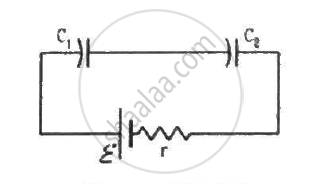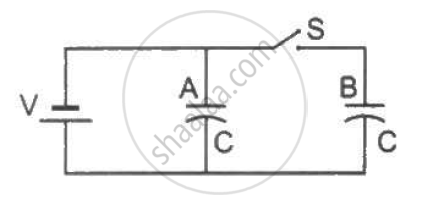Advertisements
Advertisements
Question
By evaluating ∫i2Rdt, show that when a capacitor is charged by connecting it to a battery through a resistor, the energy dissipated as heat equals the energy stored in the capacitor.
Solution
The growth of charge on the capacitor at time t ,
\[Q = Q_0 \left( 1 - e^{- \frac{t}{RC}} \right)\]
\[i = \frac{dQ}{dt} = \left( \frac{Q_0}{RC} \right) e^{- \frac{t}{RC}}\]
Heat dissipated during time t1 to t2,
\[U = \int_{t_1}^{t_2} i^2 Rdt\]
\[ = \frac{{Q_0}^2}{2C}\left( e^{- \frac{2 t_1}{RC}} - e^{- \frac{2 t_2}{RC}} \right)\]
\[ \because Q_0 = C V_{0,} \]
\[ U = \frac{1}{2}C {V_0}^2 \left( e^{- \frac{2 t_1}{RC}} - e^{- \frac{2 t_2}{RC}} \right)\]
The potential difference across a capacitor at any time t,
\[V = V_0 \left( 1 - e^{- \frac{t}{RC}} \right)\]
The energy stored in the capacitor at any time t,
\[E = \frac{1}{2}C V^2 = \frac{1}{2}C {V_0}^2 \left( 1 - e^{- \frac{2t}{RC}} \right)^2\]
∴ The energy stored in the capacitor from t1 to t2,
\[E = \frac{1}{2}C {V_0}^2 \left( e^{- \frac{2 t_1}{RC}} \right) - \frac{1}{2}C {V_0}^2 \left( 1 - e^{- \frac{2 t_2}{RC}} \right)\]
\[ \Rightarrow E = \frac{1}{2}C {V_0}^2 \left( e^{- \frac{2 t_1}{RC}} - e^{- \frac{2 t_2}{RC}} \right)\]
APPEARS IN
RELATED QUESTIONS
A 12 pF capacitor is connected to a 50 V battery. How much electrostatic energy is stored in the capacitor?
Find the ratio of energy stored in the two configurations if they are both connected to the same source.
The energy density in the electric field created by a point charge falls off with the distance from the point charge as
A 20 μF capacitor is joined to a battery of emf 6.0 V through a resistance of 100 Ω. Find the charge on the capacitor 2.0 ms after the connections are made.
How many time constants will elapse before the current in a charging RC circuit drops to half of its initial value? Answer the same question for a discharging RC circuit.
A capacitor of capacitance C is connected to a battery of emf ε at t = 0 through a resistance R. Find the maximum rate at which energy is stored in the capacitor. When does the rate have this maximum value?
A capacitor of capacitance 12.0 μF is connected to a battery of emf 6.00 V and internal resistance 1.00 Ω through resistanceless leads. 12.0 μs after the connections are made, what will be (a) the current in the circuit (b) the power delivered by the battery (c) the power dissipated in heat and (d) the rate at which the energy stored in the capacitor is increasing?
A capacitance C charged to a potential difference V is discharged by connecting its plates through a resistance R. Find the heat dissipated in one time constant after the connections are made. Do this by calculating ∫ i2R dt and also by finding the decrease in the energy stored in the capacitor.
Consider the situation shown in figure. The switch is closed at t = 0 when the capacitors are uncharged. Find the charge on the capacitor C1 as a function of time t.

A capacitor of capacitance C is given a charge Q. At t = 0, it is connected to an uncharged capacitor of equal capacitance through a resistance R. Find the charge on the second capacitor as a function of time.
A capacitor of capacitance C is given a charge Q. At t = 0, it is connected to an ideal battery of emf ε through a resistance R. Find the charge on the capacitor at time t.
Figure shows two identical parallel plate capacitors connected to a battery through a switch S. Initially, the switch is closed so that the capacitors are completely charged. The switch is now opened and the free space between the plates of the capacitors is filled with a dielectric of dielectric constant 3. Find the ratio of the initial total energy stored in the capacitors to the final total energy stored.

Answer the following question.
Obtain the expression for the energy stored in a capacitor connected across a dc battery. Hence define energy density of the capacitor
If the p. d. across a capacitor is increased from 10 V to 30 V, then the energy stored with the capacitor ____________.
A parallel plate condenser is immersed in an oil of dielectric constant 2. The field between the plates is ______.
An air-filled parallel plate capacitor has a uniform electric field `overset(->)("E")` in the space between the plates. If the distance between the plates is 'd' and the area of each plate is 'A', the energy stored in the capacitor is ______
(∈0 = permittivity of free space)
A parallel plate capacitor has a uniform electric field `overset(->)("E")` in the space between the plates. If the distance between the plates is ‘d’ and the area of each plate is ‘A’, the energy stored in the capacitor is ______
(ε0 = permittivity of free space)
In a capacitor of capacitance 20 µF, the distance between the plates is 2 mm. If a dielectric slab of width 1 mm and dielectric constant 2 is inserted between the plates, what is the new capacitance?
